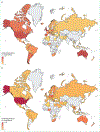Responding to global stimulant use: challenges and opportunities
- PMID: 31668409
- PMCID: PMC6924572
- DOI: 10.1016/S0140-6736(19)32230-5
Responding to global stimulant use: challenges and opportunities
Erratum in
-
Department of Error.Lancet. 2019 Nov 16;394(10211):1806. doi: 10.1016/S0140-6736(19)32723-0. Lancet. 2019. PMID: 31741454 No abstract available.
Abstract
We did a global review to synthesise data on the prevalence, harms, and interventions for stimulant use, focusing specifically on the use of cocaine and amphetamines. Modelling estimated the effect of cocaine and amphetamine use on mortality, suicidality, and blood borne virus incidence. The estimated global prevalence of cocaine use was 0·4% and amphetamine use was 0·7%, with dependence affecting 16% of people who used cocaine and 11% of those who used amphetamine. Stimulant use was associated with elevated mortality, increased incidence of HIV and hepatitis C infection, poor mental health (suicidality, psychosis, depression, and violence), and increased risk of cardiovascular events. No effective pharmacotherapies are available that reduce stimulant use, and the available psychosocial interventions (except for contingency management) had a weak overall effect. Generic approaches can address mental health and blood borne virus infection risk if better tailored to mitigate the harms associated with stimulant use. Substantial and sustained investment is needed to develop more effective interventions to reduce stimulant use.
Copyright © 2019 Elsevier Ltd. All rights reserved.
Conflict of interest statement
Declaration of interests
MF and LD have received investigator-initiated untied educational grants for studies of opioid medications in Australia from Indivior, Mundipharma, and Seqirus. RA has received untied educational grants from Reckitt Benckiser/Indivior and Mundipharma for studies of opioid substitution and agonist medication treatments in Australia. NKM has received unrestricted research grants to her university from Gilead and Merck unrelated to this work. MT has received educational grants in Spain from Gilead, Merck Sharp & Dohme, Servier, and Lundbeck unrelated to this work. JR has received educational grants from Lundbeck GmbH. SS has received clinical supplies from Alkermes and Medicinova for randomised trials outside of the submitted work. ES, AB, JAC, LTT, and RM report no competing interests.
Figures



References
-
- International Narcotics Control Board 2010. Report of the International Narcotics Control Board on the availability of internationally controlled drugs: ensuring adequate access for medical and scientific purposes New York NY: United Nations, 2011.
-
- Grinspoon L, Bakalar JB. Coca and cocaine as medicines: an historical review. J Ethnopharmacol 1981; 3: 149–59. - PubMed
-
- Byck R Cocaine papers. New York, NY: Stonehill, 1974.
-
- UN Office on Drugs and Crime. World drug report 2018 2018. https://www.unodc.org/wdr2018/ (accessed Sept 23, 2019).

